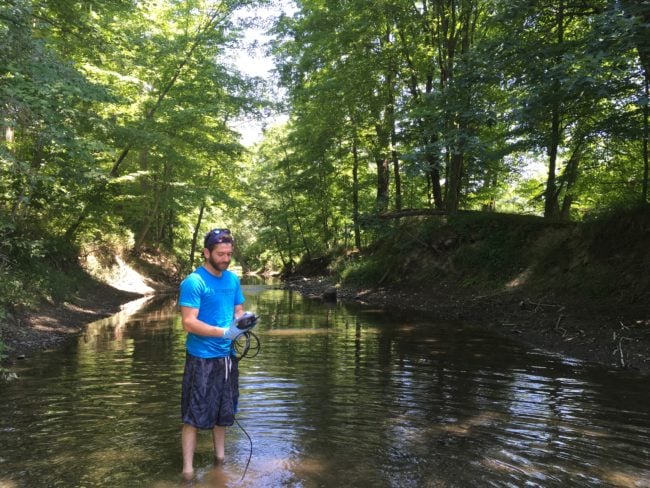Special sampling in the Wallkill River Watershed

Sebastian Pillitteri, Riverkeeper's Water Quality Associate, takes measurements in Rutgers Creek. (Photo by Dan Shapley / Riverkeeper)
View more images on our Flickr site
In 2017, in response to community concerns about water quality in the Wallkill River, the New York State Department of Environmental Conservation (DEC) began an intensive two-year watershed-scale study of the river and its tributaries. To help the DEC fill data gaps in eight tributaries, Riverkeeper is coordinating a special sampling project this summer.
Our first of five planned sampling events took place on July 10 and 11.

Sebastian Pillitteri, Riverkeeper’s Water Quality Associate, takes measurements in Rutgers Creek. (Photo by Dan Shapley / Riverkeeper)
The data DEC collected in 2017 prompted it to propose listing the Wallkill River and several tributaries as “impaired” under the Clean Water Act, due to an excess of phosphorus. The listing on the state’s 303(d) list confirms what data gathered in 2016 by Riverkeeper and the Wallkill River Watershed Alliance had showed.
Importantly, the listing will put more tools on the table to restore the river, and particularly, to prevent the recurrence of Harmful Algal Blooms, such as the one that affected 30 miles of the river for 60 days in 2016. The public can comment on this proposal to identify the impairment of the Wallkill through August 6. Riverkeeper encourages the public to support the listing of the Wallkill, and the creation of a TMDL (Total Maximum Daily Load) to reduce sources of phosphorus from permitted discharges.
The data Riverkeeper is gathering from Wallkill tributaries will complement the DEC’s intensive sampling, and provide important information necessary to prioritize interventions to reduce pollution from non-point sources of pollution, such as urban and agricultural stormwater runoff. We will pay for the processing of these samples at a commercial lab, with funding from the NYS Environmental Protection Fund, via a grant from the DEC’s Hudson River Estuary Program.
Riverkeeper’s 2018 Wallkill River sampling project is a pilot of the DEC’s PEERS (Professional External Evaluation of Rivers and Streams) project, which we anticipate will be widely available statewide to watershed groups, municipalities and others with an interest in gathering samples for DEC-partnered projects. Later in 2018, Riverkeeper will work with some of our community science partners, and the Wallkill River Watershed Alliance, to train more people in the protocols for this type of sampling, building capacity for longterm watershed stewardship.
The PEERS project is one of three sampling projects Riverkeeper is supporting in 2018 in the Wallkill River. Together with community scientists throughout the watershed, we are collecting our seventh year of monthly samples from 24 locations along the 88-mile river, in order to monitor for bacteria related to sewage or other fecal contamination – the key data to define safe recreation. And we are supporting the Wallkill River Watershed Alliance in the second year of intensive sampling in the New Paltz area to define the thresholds that predict the onset of Harmful Algal Blooms.
The Wallkill River is one of the Hudson’s largest tributaries. A healthy river requires healthy tributaries.
